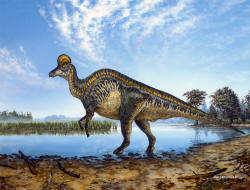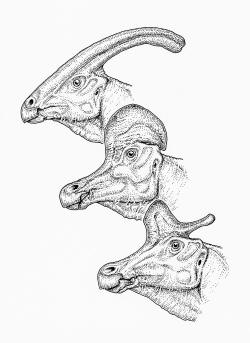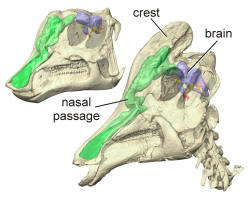
by Alexandra Ossola Thursday, January 5, 2012

The helmet-crested lambeosaur _Corythosaurus_. Courtesy of Michael Skrepnick

Three differently head-crested lambeosaurs: _Parasaurolophus_, _Corythosaurus_, and _Lambeosaurus_. Courtesy of Michael Skrepnick

Scientists used CT scanning to make models of juvenile and sub-adult lambeosaur skulls. In green: the nasal passages. In purple: the brain. Courtesy of Witmer & Ridgely, Ohio University
Paleontologists have puzzled over the lambeosaur, an odd-looking duck-billed dinosaur, since its fossils were discovered in 1914. In particular, scientists were curious about the distinctive crest on the lambeosaur’s head: Elongated and complex nasal passages led air from the dinosaur’s nostrils up into the hollow crest and back down into its lungs. But what purpose these nasal passages served was a mystery — until now.
“It’s nothing like anything we see in living animals; it’s very unusual,” says David Evans, an evolutionary biologist at University of Toronto in Canada. Over the years, researchers have suggested several purposes for the passages: to heighten the lambeosaur’s sense of smell, for thermoregulation to control the lambeosaur’s body temperature or, most popularly, as vocal resonators. But there wasn’t a lot of evidence to back up any one hypothesis.
To determine the nasal passages’ function, Evans and his team used CT scans to examine the passages in greater detail. From the scans, the researchers created digital molds of the lambeosaur’s inner ear and brain. With this model of the brain, the team looked at structures such as the olfactory lobes that correlate to the dinosaur’s sense of smell to determine whether certain senses were enhanced. The mold of the inner ear, meanwhile, allowed the team to determine which frequencies the lambeosaur could hear — and whether the sound emitted from the tuba-like nasal passages would fall into that range.
The team’s models show that the olfactory parts of the lambeosaur’s brain are quite small — “smaller than most of the lambeosaur’s closely related crestless relatives by a factor of two,” Evans says. That suggests that the enlarged nasal passages are unlikely to enhance smell. Furthermore, the models show that the sound emitted from the tubes of an adult lambeosaur would be between 50 and 375 hertz, he says — well within the hearing range of an adult lambeosaur. Therefore, Evans and his team said in a presentation at the Society of Vertebrate Paleontology annual meeting this month, the nasal passages indeed were used to make sound.
This research “is great stuff … it sorts out these hypotheses [about the crest’s function] and tests them very carefully,” says Kevin Padian, a professor in the Integrative Biology department at the University of California at Berkeley.
The vocalizations through the nasal passages probably had many different species-specific functions, Evans notes. Like many other animals, lambeosaur may have used the sounds to call and locate mates, warn other pack members of predators and communicate with its young. What the sounds do show is that lambeosaurs were social animals, he says — an idea supported by the fact that lambeosaur fossils are often found in groups. The brain molds also showed that lamebosaur brains had large hemispheres, suggesting a capacity for higher social functions.
There’s still a lot of work to do, Evans says. “We want to start scanning more specimens, different taxa and more juveniles. We also want to break down the nasal cavity by parts. We are really just scratching the surface to see the complexity of these nasal passages; some previous constructions have been way too simplistic.”
Padian suggests moving the research in another direction: “With dinosaurs that have other kinds of crests, we have to ask: Is this adaptation evolving, or just in this one animal? What are the other kinds of crests used for?” More research on the lambeosaur should lead to more breakthroughs in the function of particular parts of dinosaurs that have no living analogs.
© 2008-2021. All rights reserved. Any copying, redistribution or retransmission of any of the contents of this service without the expressed written permission of the American Geosciences Institute is expressly prohibited. Click here for all copyright requests.